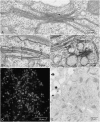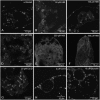Golgi regeneration after brefeldin A treatment in BY-2 cells entails stack enlargement and cisternal growth followed by division
- PMID: 17704232
- PMCID: PMC2048719
- DOI: 10.1104/pp.107.104919
Golgi regeneration after brefeldin A treatment in BY-2 cells entails stack enlargement and cisternal growth followed by division
Abstract
Brefeldin A (BFA) treatment stops secretion and leads to the resorption of much of the Golgi apparatus into the endoplasmic reticulum. This effect is reversible upon washing out the drug, providing a situation for studying Golgi biogenesis. In this investigation Golgi regeneration in synchronized tobacco BY-2 cells was followed by electron microscopy and by the immunofluorescence detection of ARF1, which localizes to the rims of Golgi cisternae and serves as an indicator of COPI vesiculation. Beginning as clusters of vesicles that are COPI positive, mini-Golgi stacks first become recognizable 60 min after BFA washout. They continue to increase in terms of numbers and length of cisternae for a further 90 min before overshooting the size of control Golgi stacks. As a result, increasing numbers of dividing Golgi stacks were observed 120 min after BFA washout. BFA-regeneration experiments performed on cells treated with BFA (10 microg mL(-1)) for only short periods (30-45 min) showed that the formation of ER-Golgi hybrid structures, once initiated by BFA treatment, is an irreversible process, the further incorporation of Golgi membranes into the ER continuing during a subsequent drug washout. Application of the protein kinase A inhibitor H-89, which effectively blocks the reassembly of the Golgi apparatus in mammalian cells, also prevented stack regeneration in BY-2 cells, but only at very high, almost toxic concentrations (>200 microm). Our data suggest that under normal conditions mitosis-related Golgi stack duplication may likely occur via cisternal growth followed by fission.
Figures






Similar articles
-
Reevaluation of the effects of brefeldin A on plant cells using tobacco Bright Yellow 2 cells expressing Golgi-targeted green fluorescent protein and COPI antisera.Plant Cell. 2002 Jan;14(1):237-61. doi: 10.1105/tpc.010237. Plant Cell. 2002. PMID: 11826310 Free PMC article.
-
Brefeldin A action and recovery in Chlamydomonas are rapid and involve fusion and fission of Golgi cisternae.Plant Biol (Stuttg). 2007 Jul;9(4):489-501. doi: 10.1055/s-2006-924759. Epub 2007 Feb 15. Plant Biol (Stuttg). 2007. PMID: 17301935
-
1-Butanol targets the Golgi apparatus in tobacco BY-2 cells, but in a different way to Brefeldin A.J Exp Bot. 2007;58(12):3439-47. doi: 10.1093/jxb/erm194. J Exp Bot. 2007. PMID: 17977851
-
The stack of the golgi apparatus.Arch Histol Cytol. 2002 Aug;65(3):209-18. doi: 10.1679/aohc.65.209. Arch Histol Cytol. 2002. PMID: 12389660 Review.
-
Brefeldin A effects in plant and fungal cells: something new about vesicle trafficking?J Microsc. 1996 Feb;181(Pt 2):162-77. doi: 10.1046/j.1365-2818.1996.112393.x. J Microsc. 1996. PMID: 8919983 Review.
Cited by
-
The Synthetic Cannabinoid WIN55,212-2 Can Disrupt the Golgi Apparatus Independent of Cannabinoid Receptor-1.Mol Pharmacol. 2022 May;101(5):371-380. doi: 10.1124/molpharm.121.000377. Epub 2022 Mar 2. Mol Pharmacol. 2022. PMID: 35236771 Free PMC article.
-
Oryzalin bodies: in addition to its anti-microtubule properties, the dinitroaniline herbicide oryzalin causes nodulation of the endoplasmic reticulum.Protoplasma. 2009 Jul;236(1-4):73-84. doi: 10.1007/s00709-009-0059-2. Epub 2009 Jun 26. Protoplasma. 2009. PMID: 19557498
-
Vacuolar degradation of plant organelles.Plant Cell. 2024 Sep 3;36(9):3036-3056. doi: 10.1093/plcell/koae128. Plant Cell. 2024. PMID: 38657116 Free PMC article. Review.
-
Organization of Xylan Production in the Golgi During Secondary Cell Wall Biosynthesis.Plant Physiol. 2019 Oct;181(2):527-546. doi: 10.1104/pp.19.00715. Epub 2019 Aug 20. Plant Physiol. 2019. PMID: 31431513 Free PMC article.
-
Vesicles versus Tubes: Is Endoplasmic Reticulum-Golgi Transport in Plants Fundamentally Different from Other Eukaryotes?Plant Physiol. 2015 Jun;168(2):393-406. doi: 10.1104/pp.15.00124. Epub 2015 Apr 16. Plant Physiol. 2015. PMID: 25883241 Free PMC article. Review.
References
-
- Altan-Bonnet N, Sougrat R, Lippincott-Schwartz J (2004) Molecular basis for Golgi maintenance and biogenesis. Curr Opin Cell Biol 16 364–372 - PubMed
-
- Aniento F, Matsuoka K, Robinson DG (2006) ER-to-Golgi transport: the COPII-pathway. In DG Robinson, ed, The Plant Endoplasmic Reticulum. Springer-Verlag, Berlin, pp 99–124
-
- Aridor M, Balch WE (2000) Kinase signaling initiates coat complex II (COPII) recruitment and export from the mammalian endoplasmic reticulum. J Biol Chem 275 35673–35676 - PubMed
Publication types
MeSH terms
Substances
LinkOut - more resources
Full Text Sources
Research Materials

